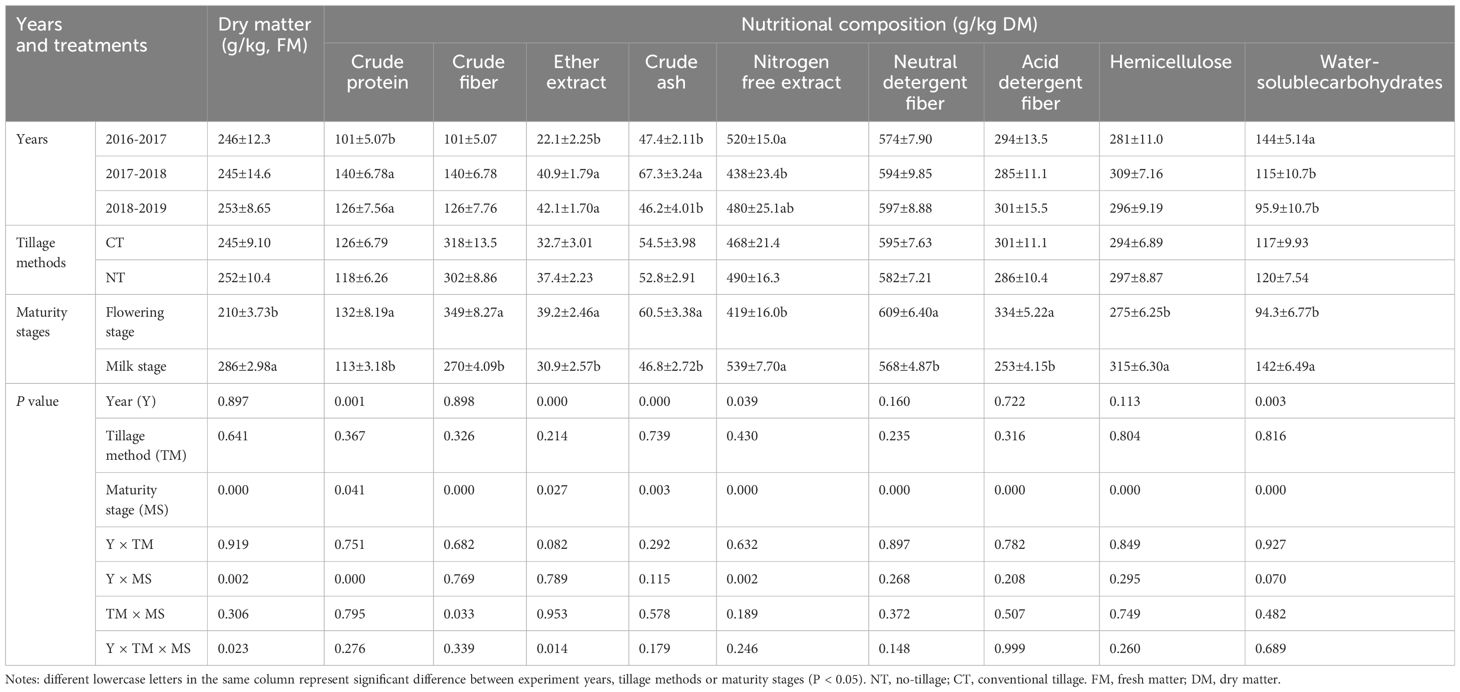- 1Department of Grassland Science, South China Agricultural University, Guangzhou, China
- 2College of Agronomy and Life Sciences, Zhaotong University, Zhaotong, China
- 3School of Biological Sciences and Technology, Liupanshui Normal University, Liupanshui, China
Whole-crop wheat (Triticum aestivum, WCW) has a high nutritional value and digestibility. No-tillage (NT) can reduces energy and labor inputs in the agricultural production process, thus decreasing production costs. There are many studies on planting techniques of WCW at present, few being on no-tillage planting. This study aimed to compare the effects of different tillage methods and maturity stages on the yield, nutritive value, and silage fermentation quality of WCW. The experiment included two tillage methods (NT; conventional tillage, CT), two maturity stages (flowering stage; milk stage), and three years (2016-2017; 2017-2018; 2018-2019). Years had a strong influence on the yield and nutritional composition of WCW. This was mainly related to the amount of rainfall, as it affects the seedling emergence rate of wheat. Although tillage methods showed no significant effects on the yield, plant height, and stem number per plant of WCW (P > 0.05), compared to CT, the dry matter (DM) and crude protein (CP) yields of NT decreased by 0.74 t/ha and 0.13 t/ha. Tillage methods showed no significant effects on the nutritive composition of WCW (P > 0.05). The WCW at the milk stage had greater DM (5.25 t/ha) and CP (0.60 t/ha) yields than that at the flowering stage (3.19 t/ha and 0.39 t/ha) (P< 0.05). The acid detergent fiber concentration of WCW decreased by 34.5% from the flowering to the milk stage, whereas water-soluble carbohydrates concentration increased by 50.6%. The CP concentration at the milk stage was lower than that at the flowering stage (P< 0.05). The lactic acid concentration of NT (17.1 g/kg DM) silage was lower than that of CT (26.6 g/kg DM) silage (P< 0.05). The WCW silage at the milk stage had a lower NH3-N concentration (125 g/kg TN) than that at the flowering stage (169 g/kg TN) (P< 0.05). Wheat sown by NT and CT was of similar yield and nutritional value, irrespective of harvest stages. WCW harvested at the milk stage had greater yield and better nutritional composition and silage fermentation quality than that at the flowering stage. Based upon the results of the membership function analysis, no-tillage sowing of wheat was feasible and harvesting at milk stage was recommended.
1 Introduction
China’s population accounts for 17% of the world’s population, and with its growth, the acceleration of urbanization process and the increase of income, food consumption patterns have gradually changed. From 1961 to 2017, the food consumption structure (grain and livestock products) of domestic population changed substantially in China. In the structure of daily food consumption, the proportion of grain had decreased (Ren et al., 2017). Nationally, the yield of livestock products (pork, beef and mutton) has increased from 4.83 × 107 t in 2000 to 6.52 × 107 t in 2017 (Xu et al., 2023). However, it is worth noting that the dairy intake of domestic residents is still insufficient due to scarce supply of forage (Lin et al., 2021). In this context, the Chinese government has formulated several policies to support forage production and processing. For example, to prevent competition with food crops for land, increasing the planting area of forage crops and exploiting new forage resources by using idle land resources (such as fallow lands) have effectively alleviated forage shortage. In general, winter fallow fields were planted with green manure (the objective of improving soil fertility through the cultivation of green crops was to increase the yield of subsequent crops) or fallow in southern China. In recent decades, fluctuations in geopolitics, international exchange rates, and energy prices (Alam et al., 2022), have led to rising feed costs, and livestock producers have had to consider additional ways to obtain more feed and protein.
In Australia’s high rainfall zone, dual-purpose wheat (Triticum aestivum) is used to increase meat and wool production (McGrath et al., 2021). In Brazil, dual-purpose wheat is used for grazing, which increases meat production and improves the profitability of integrated crop-livestock systems (Timm et al., 2020). The whole crop wheat (WCW) has a high water-soluble carbohydrate (WSC) concentration, which facilitates the production of high-quality silage (especially during the milk stage) (Filya, 2003). At the same time, WCW after ensilaged has a high lactic acid concentration, which makes it a high-quality silage (Xie et al., 2012). Regarding animal production performance, WCW harvested at dough-stage has a high starch concentration, which is completely digested in dairy cows (Randby et al., 2019). Additionally, some studies showed that feeding WCW silage to ewe increases their efficiency of energy utilization compared to grass silage (Higgins et al., 2020). In pursuit of higher dry matter (DM) and crude protein (CP) yields and better silage fermentation quality, WCW is typically harvested at the late milk or early dough stage (Xie et al., 2012). However, at more mature stages of WCW growth, widespread lignification of stem internodes and leaf sheaths occurs, which reduces the digestibility of forage straw (Weinberg et al., 1991). Therefore, despite lower yield, some producers may harvest WCW at the flowering stage (Xie et al., 2012).
Traditionally, early rice (Oryza sativa, planting in Apr.)-late rice (planting in Jul.)-fallow rotation has been a popular cropping practice in southern China. Winter fallow (from Nov. to Mar. the next year) is usually used to save materials, seeds, labor, and energy inputs, but it wastes water and land resources. More importantly, planting forage crops during the fallow period increases economic profits (Xu et al., 2021a). In addition, the utilization of winter green manure crops is also a traditional method for improving the grain yield of subsequent crops in southern China. However, this will lead to the loss of forage. In the previous study, we found that winter fallow fields can be used to plant a season of forage wheat (Xu et al., 2021b). In the light of the above background, the southern China region is currently planting winter wheat to increase the local supply of forage.
No-tillage (NT) can reduce soil erosion and increase soil nutrient concentration availability, hence is widely adopted in agricultural production. It also reduces energy and labor inputs in the agricultural production process, thus decreasing production costs. However, the effect of NT on grain yield remains inconsistent (Pittelkow et al., 2015). As an important component of the whole plant, the grain inevitably affects the yield and nutrition of WCW. There are many studies on planting techniques of WCW at present, few being on no-tillage planting. This study offers more options for feed producers, including: 1) compare the effects of different years and tillage methods on the yield, nutritive composition, and silage fermentation quality of WCW; 2) choosing maturity stage for harvesting WCW. We hypothesize that 1) NT improves WCW yield, nutritional value, and silage fermentation quality; 2) the yield and nutritional value of WCW at milk stage were higher than at the flowering stage.
2 Materials and methods
2.1 Site description
The experiment was conducted at the experimental field of South China Agricultural University (23˚14′N and 113˚38′E), Guangzhou, Guangdong Province, China. The experiment location was a typical site of a Chinese region of rice and fallow (or green manure) cropping systems. Soil chemical properties (0-20 cm) were organic matter of 20.4 g/kg, total nitrogen of 0.82 g/kg, nitrate nitrogen of 102 mg/kg, available phosphorus of 12.1 mg/kg, and pH of 5.33 (three years mean values). The total rainfall during the winter crop growing periods in 2016-2017, 2017-2018 and 2018-2019 were 231, 286, and 388 mm, respectively (Figure 1). The average air temperature during the winter crop growing periods in 2016-2017, 2017-2018, and 2018-2019 were 17.3, 17.0, and 18.1°C, respectively (Figure 1).
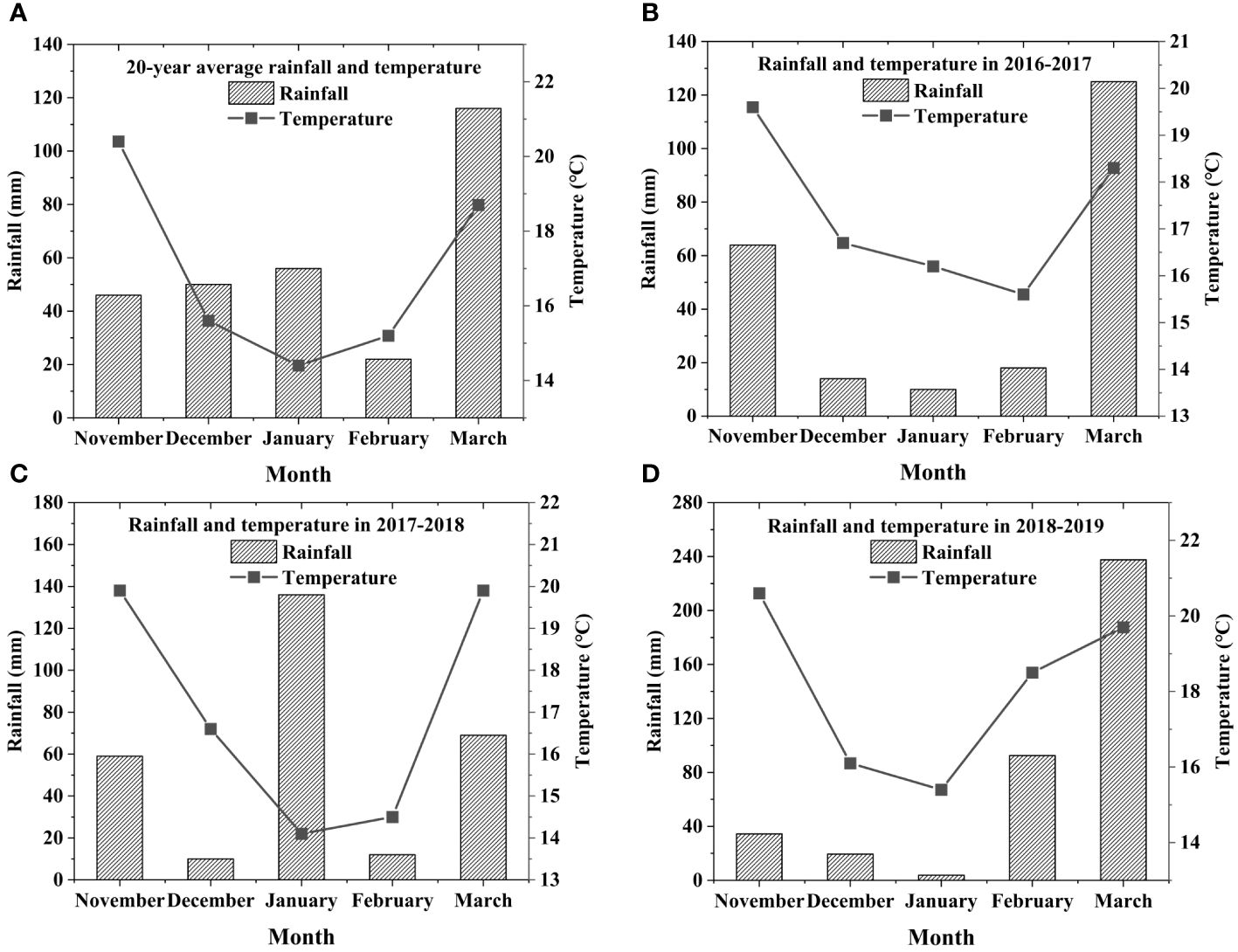
Figure 1 (A), 20-year average rainfall and temperature; (B), rainfall and temperature in 2016-2017; (C), rainfall and temperature in 2017-2018; (D), rainfall and temperature in 2018-2019.
2.2 Experimental design and management
The field trials were carried out from Nov. 2016 to Mar. 2017, Nov. 2017 to Mar. 2018 and Nov. 2018 to Mar. 2019. The experiment included tillage methods of NT and conventional tillage (CT) and maturity stages of the flowering stage and milk stage. Late rice was harvested in Nov. and then wheat was manually sown. For NT, the seeds were directly sown onto the soil surface, without tillage or action to improve the soil density. For CT, the soil was plowed with a pneumatic row direct drilling machine equipped with double disc furrow openers (XG788ZK, Guangzhou Agricultural Machinery Equipment, Guangzhou, China), and wheat seeds were manually scattered on the ground. Each plot was 3 m × 4 m, with an interval of 0.5 m between plots, and each treatment was in triplicate (randomly allocated). The wheat (Shimai-1) was sown at 285 kg/ha (NT and CT). No insecticides and fungicides were used during the experiments. WCW was not irrigated during the winter crop growing periods. The compound fertilizer (N: P2O5: K2O=15:6:8) was split-applied at 150 kg/ha. Forty percent was applied as a basal fertilizer, and the remaining fertilizer was applied at the jointing stage. The phenology of wheat was monitored according to the decimal code for the growth stages of cereals (Zadoks et al., 1974). Table 1 shows the detailed field management and growth period of wheat. To fully utilize soil water, the wheat in 2016-2017 were planted on the third day after the harvest of late rice. However, in 2017-2018 and 2018-2019, the wheat was planted on the ninth and eleventh day after the harvest of late rice, when the soil water content was relatively low. Compared to 2016-2017, the emergence time of wheat in 2017-2018 and 2018-2019 was delayed by 5 and 8 days, respectively. In addition, due to differences in soil management methods, there were differences in the utilization of soil moisture between NT and CT, resulting in a lower seedling emergence rate for NT compared to CT (Table 1).
2.3 Field sampling and silage making
The WCW was harvested when plants were at the flowering stage (DC65-69), and milk stage (DC 75-77, Zadoks et al., 1974). The fresh matter yield of WCW was determined with a 1 m2 (1.0 m × 1.0 m) quadrat, and the DM yield was calculated based on DM concentration and fresh matter yield. At harvest, 5.0 kg of fresh material was randomly selected (5 cm from the ground, mowed with a sickle) from each plot for the analyses of the number of epiphytic microbes, chemical composition, and silage making. Fresh materials were choped to 20 to 30 mm length, and mixed thoroughly after transporting to the laboratory. Then 300 g of materials were stuffed into bags (polyethylene plastic, 300 mm × 400 mm × 0.2 mm, Mingkang Packing Co. Ltd., Zhongshan, China), which were degassed and sealed using a vacuum sealing machine (Sinbo Vacuum Sealer, Hong Tai Home Electrical Appliance Co., Ltd., Hong Kong, China). All the bags were put in a laboratory cabinet (18 to 29°C, dark environment) for 60 days.
2.4 Microbial and chemical analyses
Lactic acid bacteria were cultured under anaerobic conditions at 37°C for 2 d (de Man-Rogosa-sharp agar), aerobic bacteria (nutrient agar), yeasts and molds (potato dextrose agar) were cultured under aerobic conditions at 37°C for 3 d. The DM concentration was measured at 70°C for 48 hours in an oven with forced air circulation (Blast drying oven 9003A, Shandong Jinan Haineng Instrument Co., Ltd., China Co., Ltd). CP and NH3-N concentrations were determined by Kjeldahl nitrogen determination (Nitrogen analyzer KN680, Shandong Jinan Alva Instrument Co., Ltd., Jinan, China) and ultraviolet spectrophotometer (Brodeick and Kang, 1980), respectively. The analyses of ether extract and crude fiber concentrations were conducted as outlined in AOAC (1990). Crude ash concentration was measured by burning in a muffle furnace at 550°C for 5 hours. Crude fiber (CF), neutral detergent fiber (NDF), and acid detergent fiber (ADF) concentrations were determined by a filter bag method (Ankom Technology, Macedon, NY) (Van Soest et al., 1991). The buffering capacity and WSC concentration were measured using the method described by Playne and McDonald (1966) and Murphy (1958), respectively. Hemicellulose concentration was calculated from the difference between NDF and ADF concentrations. Relative feed value (RFV) was calculated based on ADF and NDF (Rohweder et al., 1978).
The pH of the extract was measured using a pH meter (LE438 pH meter, Mettler Toldeo, Shanghai, China). The concentration of organic acid (lactic acid, acetic acid, propionic acid, and butyric acid) was measured by the high performance liquid chromatography (column: Sodex RS Pak KC-811, Showa Denko K.K., Kawasaki, Japan; detector: DAD, 210 nm, SPD-20A, Shimadzu Co., Ltd, Kyoto, Japan; eluent: 3 mmol/L HClO4, 1.0 ml/min; temperature: 60°C).
2.5 Statistical analysis
The ANOVA method was used to assess the effects and their interactions of years, tillage methods, and maturity stages on the yield, nutritive composition, and silage fermentation quality. When ANOVA indicated a significant F-value (at the 5% probability level), multiple comparisons were performed by Duncan’s multiple range method (SPSS 17.0 for Windows; SPSS Inc., Chicago, IL, USA). The model used was
where Y was the response variable, μ was the overall mean, Ti was the effect of treatment, and ϵij was the residual error.
Relationships among yield and nutritional composition or among nutritional composition and silage fermentation quality of forage were examined by Pearson correlation. Analyses for the yield, chemical composition and silage fermentation quality of different years, tillage methods, and maturity stages were carried out using the principal component analysis function. Based on the information of WCW yield, nutritive composition, and silage fermentation quality, the fuzzy membership function analysis method was used to sort the years, tillage methods, and maturity stages (OriginPro®2021b software, OriginLab Corp., WA, USA).
3 Results
3.1 Yield and agronomic characters
Table 1 indicates the harvesting time occurred later in growth stage in 2016-2017 than in 2017-2018 and 2018-2019. As shown in Table 2, the DM and CP yields were affected by three sources of variation: years, maturity stages, and year × maturity stage interaction (P< 0.05). Although tillage methods showed no significant effects on the yield, plant height, and stem number per plant of WCW (P > 0.05), compared to CT, the DM and CP yields of NT decreased by 0.74 t/ha and 0.13 t/ha. The DM and CP yields of WCW in 2016-2017 (6.75 t/ha and 0.71 t/ha) were higher than those in 2017-2018 (3.19 t/ha and 0.43 t/ha) and 2018-2019 (2.73 t/ha and 0.34 t/ha) (P< 0.05). The WCW at the milk stage had greater DM (5.25 t/ha) and CP (0.60 t/ha) yields than that at the flowering stage (3.19 t/ha and 0.39 t/ha) (P< 0.05).
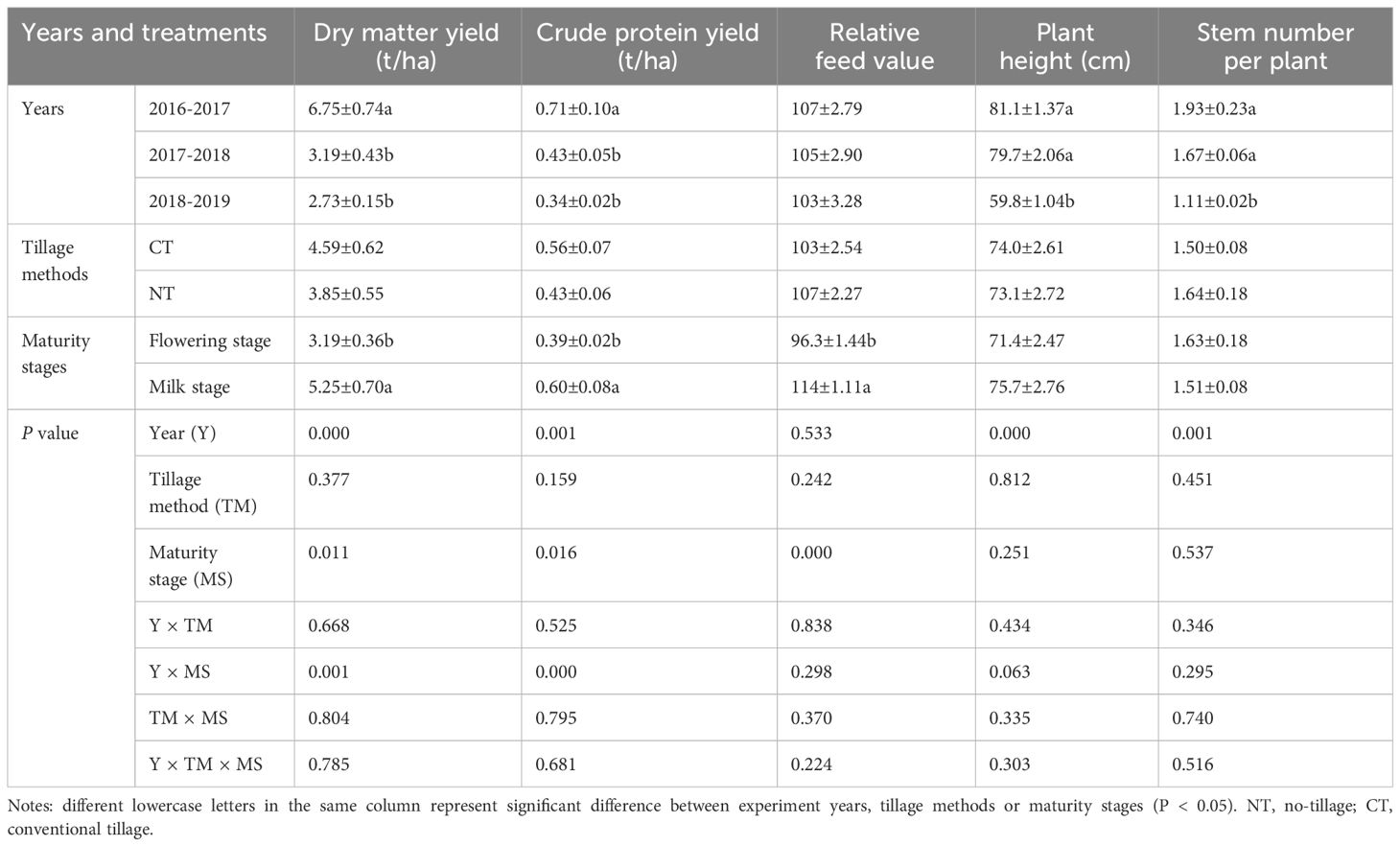
Table 2 Yield, plant height and stem number per plant of different years, tillage methods and maturity stages (n=36).
3.2 Chemical and microbial compositions
As shown in Table 3, the WCW at the milk stage had greater DM, NFE, HC, and WSC concentrations than that at the flowering stage, while the concentrations of CP, CF, ether extract, crude ash, NDF and ADF was lower (P< 0.05). Compared with at the milk stage, the WSC concentration at the flowering stage decreased 47.7 g/kg DM, and the NDF and ADF concentrations increased by 41 g/kg DM and 81 g/kg DM, respectively. Therefore, WCW had higher RFV at the milk stage (114) than at the flowering stage (96.3) (P< 0.05) (Table 2). Tillage methods showed no significant effects on nutritive compositions (P > 0.05), but NT tended to reduce NDF and ADF concentrations. The CP and ether extract concentrations in 2017-2018 (140 g/kg DM and 40.9 g/kg DM) and 2018-2019 (126 g/kg DM and 42.1 g/kg DM) were greater than those in 2016-2017 (101 g/kg DM and 22.1 g/kg DM) (P< 0.05).
The tillage methods had no significant effects on the buffering capacity, pH, and numbers of all microorganisms (P > 0.05) (Table 4). The pH and numbers of all microorganisms were significantly affected by years (P< 0.05). The highest numbers of aerobic bacteria (7.28 lg cfu/g FM) and yeasts (3.48 lg cfu/g FM), and the lowest number of lactic acid bacteria (2.00 lg cfu/g FM) presented on WCW in 2016-2017. The WCW at the milk stage had less aerobic bacteria (6.35 lg cfu/g FM) and yeasts (2.50 lg cfu/g FM) than that at the flowering stage (7.01 lg cfu/g FM and 3.28 lg cfu/g FM) (P< 0.05) (Table 4).
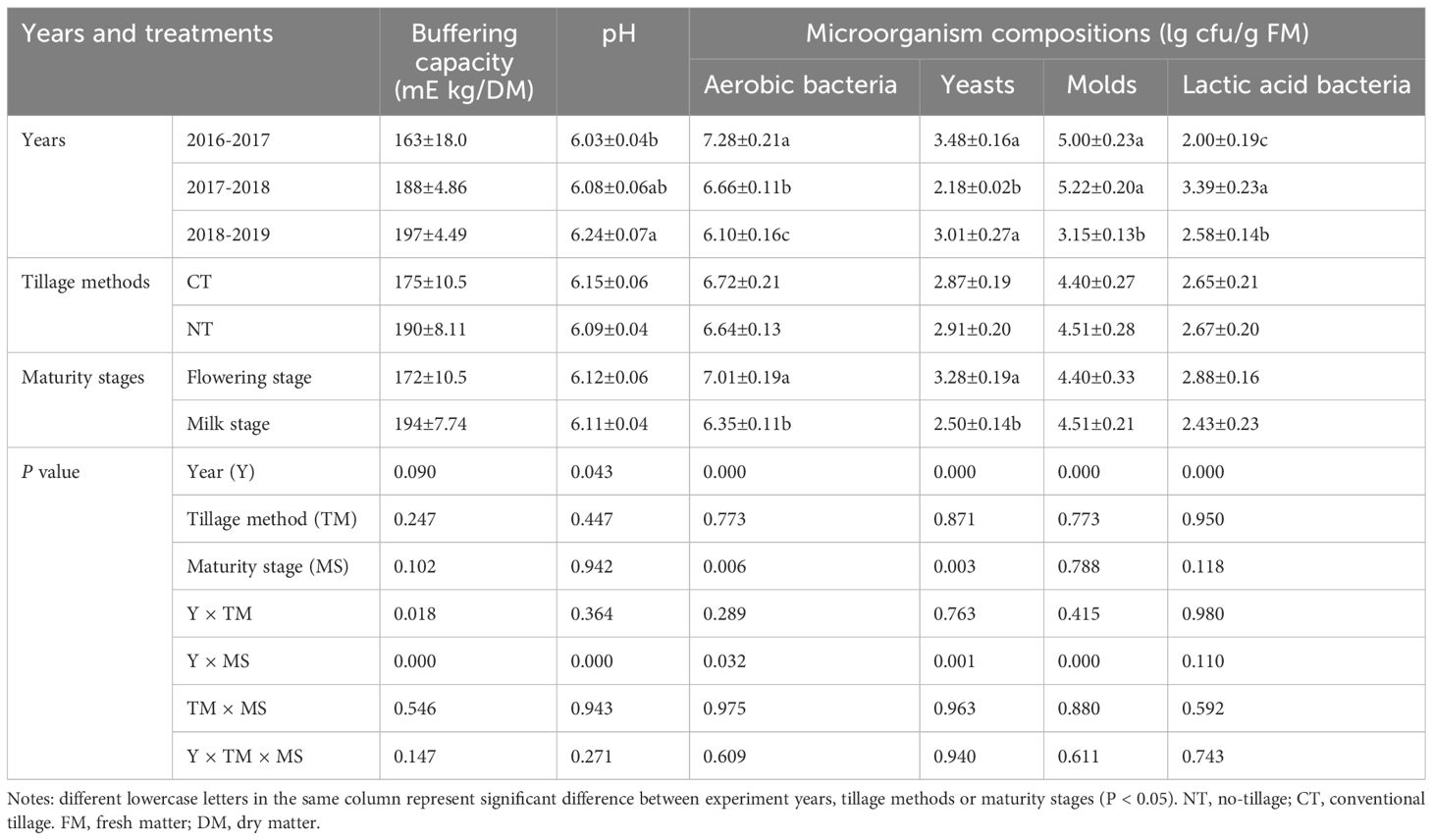
Table 4 Measurements of buffering capacity, pH and microorganism compositions of different years, tillage methods and maturity stages (n=36).
3.3 Silage fermentation quality
Tillage methods, maturity stages, and their interaction showed no significant effects on the pH value and acetic acid, propionic acid, and butyric acid concentrations of WCW silage (P > 0.05) (Table 5). Experimental years had significant effects on the pH value, lactic acid, and NH3-N concentration of WCW silage (P< 0.05). The lactic acid concentration of silage in 2016-2017 (31.6 g/kg DM) were greater than those in 2017-2018 (20.1 g/kg DM) and 2018-2019 (21.4 g/kg DM) (P< 0.05), and the lowest NH3-N concentration was achieved in 2016-2017 (107 g/kg TN) (P< 0.05). The lactic acid concentration of NT (17.1 g/kg DM) was lower than that of CT (26.6 g/kg DM) (P< 0.05). WCW silage at milk stage had lower NH3-N concentration (125 g/kg TN) than that at flowering stage (169 g/kg TN) (P< 0.05) (Table 5).
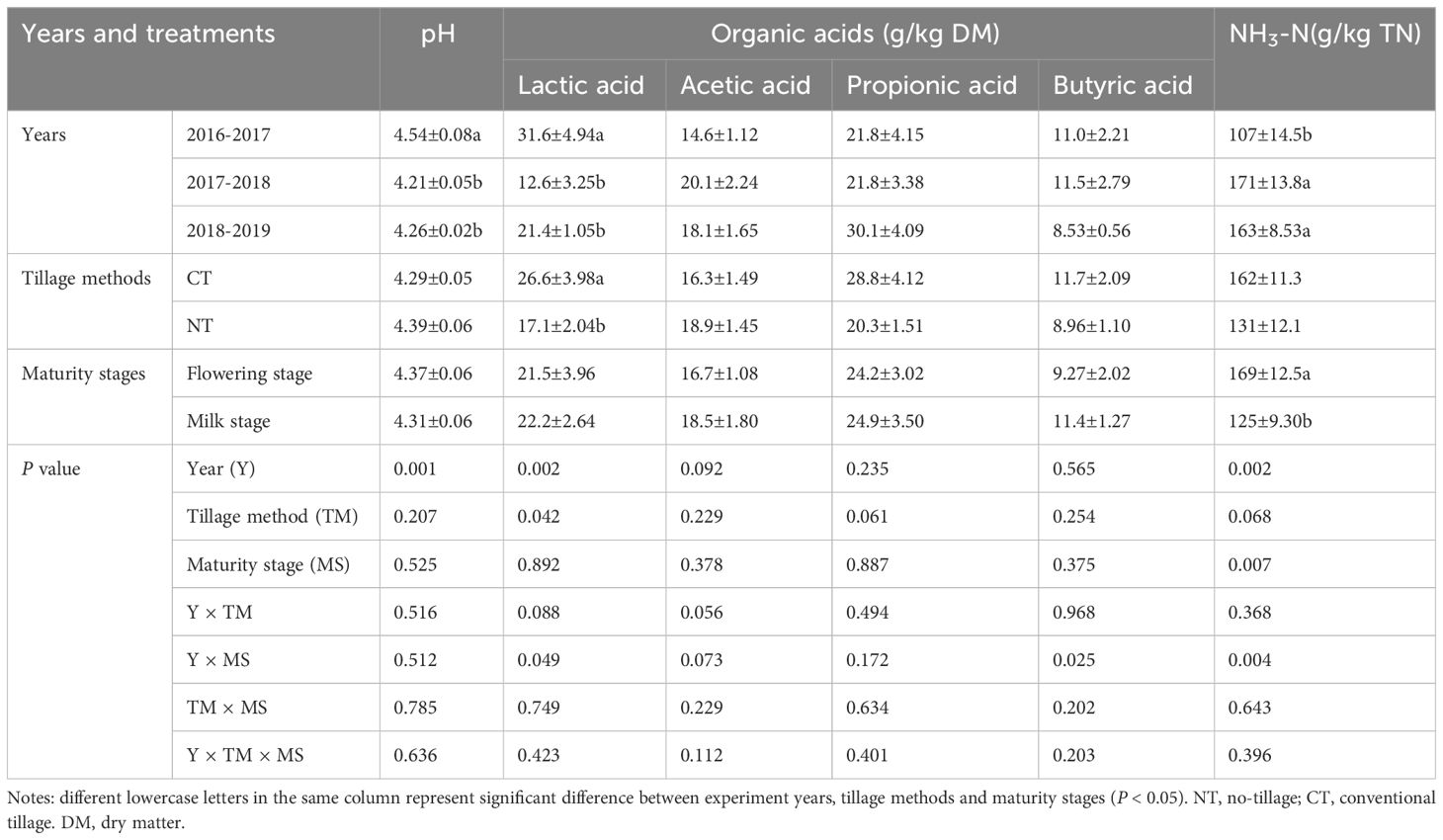
Table 5 Silage fermentation measurements of different years, tillage methods and maturity stages (n=36).
3.4 Interrelation pattern among the yield, nutritive composition, and silage fermentation quality
Correlation analyses showed that the DM yield of WCW was negatively correlated with CP, ether extract, crude ash and NDF concentrations (P< 0.05) (Table 6). The number of aerobic bacteria was significantly positively correlated with the pH of WCW silage (P< 0.05). The concentrations of DM and WSC and number of yeasts and lactic acid bacteria of WCW prior to ensiling had a negative correlation to NH3-N concentration of WCW silage, while the CP, crude fiber, ether extract, crude ash, ADF, and NDF concentrations of WCW, before ensiling, had a positive correlation to the NH3-N concentration of WCW silage (P< 0.05). The buffering capacity of WCW before ensiling was negatively correlated with the lactic acid concentration of WCW silage (P< 0.01) (Table 6).
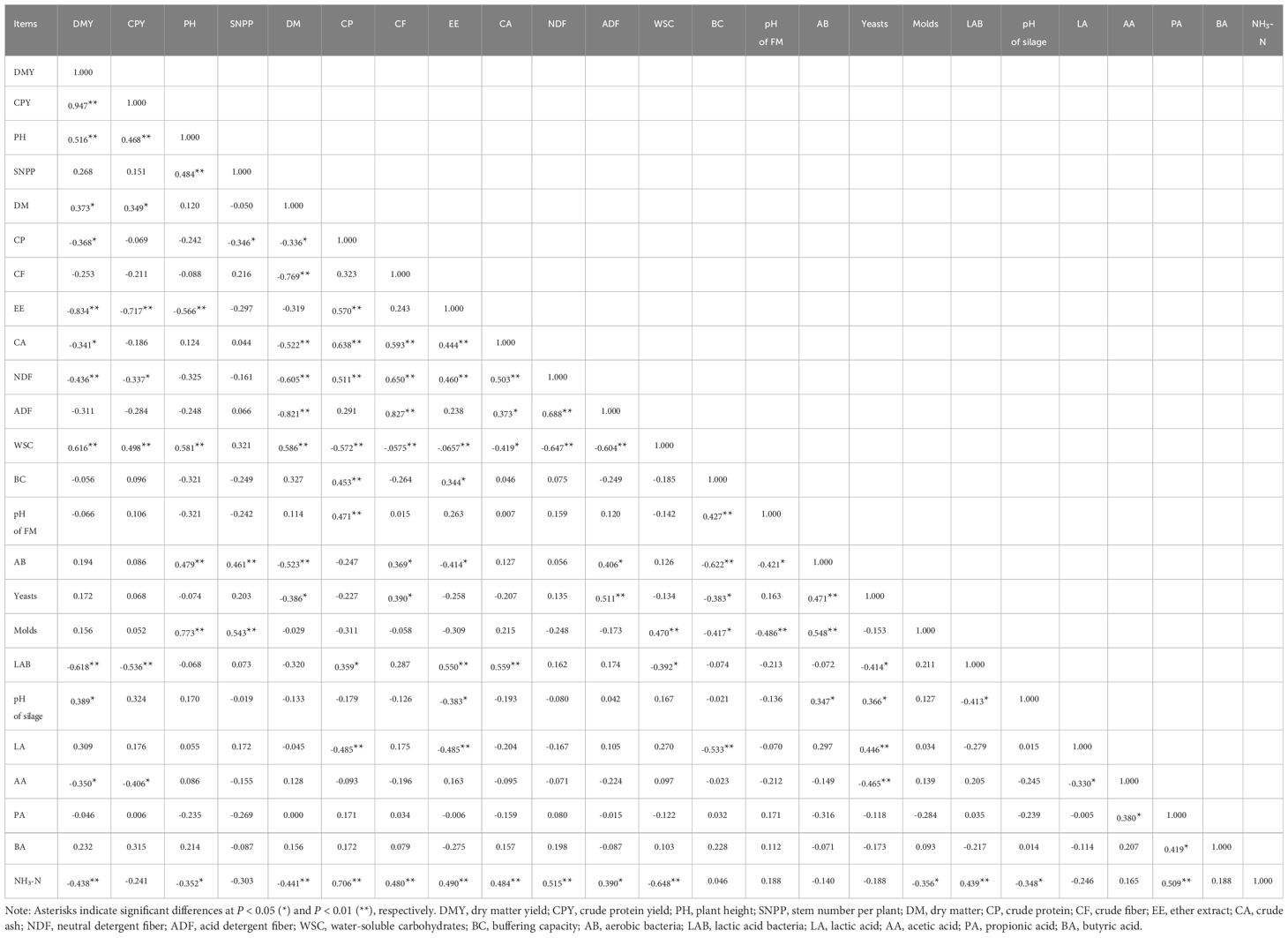
Table 6 Correlation plot of Pearson among yield, nutritional composition and silage fermentation quality of whole crop wheat (n=36).
The interrelationships of yields and quality indicators of WCW were relatively consistent and steady regardless of tillage methods, while silage fermentation quality indicators varied between maturity stages (Tables 2, 3, 5; Figure 2). Twenty-seven initial variables were reduced to four variables that contained information about most of the original variables (four indicators were not related to each other) (not listed). The eigenvalues of these four principal components were all greater than 1, indicating the principle of extraction as principal components was reasonable. In the initial eigenvalues, the cumulative variance contribution rate of the four principal components extracted and loaded was 96.5%. Specifically, the WCW at the milk stage had the highest yield, DM, and WSC content (Tables 2, 3), which was clearly separated from the flowering stage along the first axis (Figure 2). On the other hand, 2016-2017 had the highest yield, WSC and NFE contents, which was clearly separated from the other two years along the first axis (Figure 2). However, there were no differences in most yield, nutrients, and silage fermentation quality of two tillage methods. This was also the reason that the 95% confidence intervals overlap. According to the results of the membership function analysis, 2017-2018 scored the highest in years, NT scored the highest in tillage methods, milk stage scored the highest in maturity stages (Supplementary Table 1).
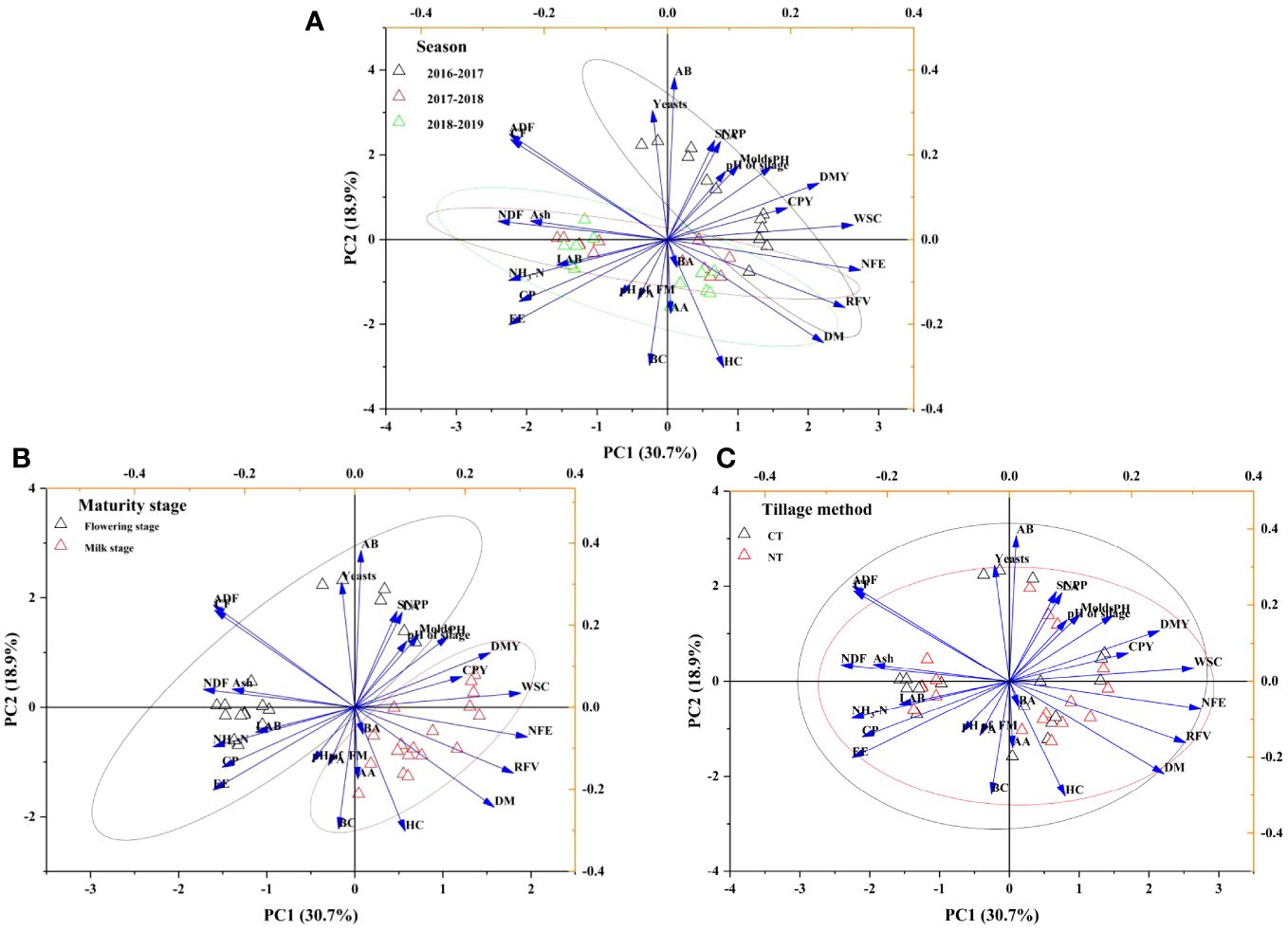
Figure 2 Scatter diagram of principal component analysis of agronomic characts, yields, and relative feed value of different years (A), tillage methods (B) and maturity stages (C). The ellipse indicates 95% confidence. NT, no-tillage; CT, conventional tillage. DMY, dry matter yield; CPY, crude protein yield; RFV, relative feed value; PH, plant height; SNPP, stem number per plant; FM, fresh matter; DM, dry matter; CP, crude protein; CF, crude fiber; Ash, crude ash; EE, ether extract; NFE, nitrogen free extract; NDF, neutral detergent fiber; ADF, acid detergent fiber; HC, hemicellulose; BC, buffering capacity; AB, aerobic bacteria; LAB, lactic acid bacteria; LA, lactic acid; AA, acetic acid; PA, propionic acid; BA, butyric acid.
4 Discussion
4.1 Agronomic characters and yields
The DM and CP yields in 2016-2017 were greater than those in 2017-2018 and 2018-2019 (P< 0.05). The growth time of WCW in 2016-2017 was longer than that in 2017-2018 and 2018-2019 in both flowering and milk stages (Table 1), which was conducive to the accumulation of more photosynthetic products and increased the yield of WCW. Additionally, in Nov. and Dec. of 2016-2017, there was higher rainfall (64 mm and 14 mm) combined with higher temperatures (19.6°C and 16.7°C), which was beneficial for the accumulation of biomass in wheat early-stage. Several studies have found that climate has a greater impact on the yield and nutritive composition of forage crops (Ergon et al., 2018; Druille et al., 2020). However, the differences in temperature and rainfall between two years in this study, and wheat had similar morphological and anatomical at harvest (2017-2018 and 2018-2019). Principal component analysis also demonstrated a high overlap between 2017-2018 and 2018-2019 wheat in terms of yield, nutrient content and information on silage fermentation quality (Figure 2A).
Notably, moisture and temperature were the two most important factors affecting the growth process of crops. In this study, due to the perennial planting of early and late rice in the region, the shallow soil water distribution, which had a positive effect on the growth of the winter crop (low rainfall in winter). In addition, the sufficient light and heat were available for crop growth in winter. The above factors were all conducive to the growth of wheat. To pursue a higher DM yield, WCW was harvested after the dough stage (Filya, 2003). However, this is not allowed when the crop rotation system is more complex, as it might cause a delay in the sowing time of the subsequent crops, which in turn reduces the economic profitability of the rotation system. It was noted that the yield of wheat in this study was lower than those of some published data (Filya, 2003; Xie et al., 2012). Except for genotype, the reasons for these results were mainly related to the different growth stage and planting environment of wheat.
In the previous study, we found that the population density of wheat by NT (1.54 × 106 plant/ha) was significantly lower than that of CT (2.09 × 106 plant/ha), and similar results were obtained in the experiment of no-tillage Italian ryegrass (Lolium multiflorum) (Xu et al., 2021a). However, there were no differences in the DM and CP yields between NT and CT in this study. Furthermore, there were no differences in plant height and stem number per plant between NT and CT (Table 2). This shows that the per plant dry matter and crude protein accumulation rates of NT were higher than that of CT, which can explain the consistency of their yields. Light interception has been proved to increase with the increase of population density, while the effective radiation of photosynthesis penetrating the lower vegetation layer decreases (Yang et al., 2019). This also explains that the stem number per plant of NT was slightly more than that of CT (Table 2). Except for climatic factors, soil nutrients and moisture were considered to be the main factors causing variation in the yield of crop, and proper soil structure was essential to improve soil fertility and water concentration (Xu et al., 2021b). A global meta-analysis showed that no differences in the yield of crops (rice, maize, barley, and soybean) were observed between NT and CT (Shakoor et al., 2021). In the previous study, we found that no-tillage reduced disturbance and preserved more nutrients and water in soil than CT (Xu et al., 2021b). Furthermore, under NT conditions, soil water evaporation was limited and more water was available to the crop. In this study, the key factor affecting the growth of WCW was rainfall in different years. Therefore, we speculate that NT treatment suppressed the evaporation of soil water and ensured that wheat had an adequate water supply during the filling period. It was worth noting that there were differences in water supply between tillage treatments (Xu et al., 2021b). This also compensated for the risk of yield reduction due to lower population density. The reason maybe that the seeds were directly sown on the surface of the soil, resulting in a low germination rate in this study (small contact area between seed and soil, weak water absorption of seed, and no irrigation). The sample size (3 plots replicates of 1 × 1 m2) was supposed to alter the results. Principal component analysis also demonstrated a high overlap between NT and CT wheat in terms of yield, nutrient content and information on silage fermentation quality (Figure 2C). However, the results based on the analysis of the affiliation function showed that the years and maturity stages had a great impact on forage yield and nutrition (Supplementary Table 1).
The greater DM and CP yields at the milk stage than at the flowering stage were due to the longer development cycle of WCW (Tables 1, 2), accumulating greater photosynthetic products. This was consistent with the results of some studies about delayed grass harvest (Xie et al., 2012). Compared to flowering stage, the DM and CP yields at the milk stage increased by 1.35 t/ha and 0.21 t/ha, respectively. Evidently, WCW accumulated more photosynthetic products at milk stage.
4.2 Nutritive and microbial compositions
The WCW at milk stage had lowter NDF and ADF concentrations than at flowering stage (P< 0.05). Many research results showed that high concentrations of NDF and ADF had a negative impact on forage digestive effectiveness (Monteiro et al., 2021). The population density of CT was high, intensifying the competition for nutrients among plants. Several studies had also provided similar conclusions (Obour et al., 2019). It was worth noting that tillage methods showed no significant effects on the nutritive composition of WCW (P > 0.05). The sowing methods does not affect the nutrition of WCW through density and soil characteristics. It suggests that sowing methods does not affect nutritive composition of WCW through population density and soil properties. Similar results were obtained in the experiments of maize (Wang et al., 2020) and soybean (Yusuf et al., 1999). With increasing maturity, the ratio of grains to whole plants increased. This explains the higher DM concentration of WCW at flowering stage.
Previous studies have shown that the growth stage (or harvest time) was an important factor affecting the chemical composition of grasses (Stirling et al., 2022). In the early stages of growth, the leaves have a high proportion of the whole plant in grasses. Therefore, grasses have a high CP concentration. In this study, the NDF and ADF concentrations of WCW decreased by 6.7% and 24.3% from the flowering to the milk stage, respectively, whereas WSC concentration increased by 50.6%. Similar trends had been observed in some studies (Xie et al., 2012). WCW at the milk stage had lower CP concentration than that at the flowering stage (P< 0.05). The reason was that protein synthesis was weakened (dilution effect) as the growth period was delayed. Conversely, starch accumulation offsets lower NDF digestibility. Unfortunately, we did not study the WCW at the dough stage.
Before ensiling, there were many kinds of microorganisms on the surface of grasses, which would produce different metabolites during the ensiling and in turn determine the fermentation quality of silage. The number of aerobic bacteria was much higher than those of other microorganisms in this study. The number of lactic acid bacteria was not affected by the maturity stages (Table 4).
4.3 Silage fermentation quality
Ensiling was an effective way to preserve the nutritional quality of grasses and was a global practice to preserve the moist forage crops when drying forage is difficult (especially in the rainy season). Moreover, the general practice was to wilt the crop before ensiling, if water content is high at harvest. Years had a large influence on the silage fermentation quality of WCW in this study, while the effects of tillage methods and maturity stages on the silage fermentation quality of WCW were very limited (Table 5). This was a key issue because population density was related to the epiphytic microbial population (Table 1) and could also affect the fermentation profile. In this study, WCW at the milk stage had a lower NH3-N concentration than that at the flowering stage. This was because the higher WSC concentration of WCW at the milk stage provided more substrate for the rapid propagation of lactic acid bacteria. Moreover, the rapid reduction of pH in anaerobic environment inhibited plant and microbial protease activities, subsequently inhibiting protein degradation. Several studies had also provided similar conclusions (Xie et al., 2012). Thus, WSC concentration was negatively correlated to NH3-N concentration (Table 6), and it was adopted as a positive indicator in the evaluation of forage feeding potential. Although we did not study the microbial species in silage, we speculations there was substantial evidences of clostridial activity throughout. Across all silages, butyric acid content was >1.0% DM, while NH3-N accounted for roughly 15% of total N. Also, the propionic acid concentration was very high (about 2.5%) in all the treatments. All of these responses indicate significant clostridial activity.
5 Conclusions
This study shows that years had a strong influence on the yield and nutritional composition of whole-crop wheat in southern China. This was mainly related to the amount of rainfall, as it affects the seedling emergence rate of wheat. In addition, the interrelation patterns among the yields (DM and CP), nutritional compositions and silage fermentation quality indicators were not affected by tillage methods. Wheat sown by NT and CT was of similar yield and nutritional value, irrespective of harvest stages. WCW harvested at the milk stage had greater yield and better nutritional composition and silage fermentation quality than that at the flowering stage. No-tillage sowing of wheat was feasible and harvesting at the milk stage was recommended.
Data availability statement
The original contributions presented in the study are included in the article/Supplementary Material. Further inquiries can be directed to the corresponding author.
Author contributions
LX: Data curation, Investigation, Writing – original draft, Writing – review & editing. GT: Investigation, Writing – review & editing. DW: Data curation, Investigation, Writing – review & editing. YH: Data curation, Investigation, Writing – review & editing. JZ: Data curation, Funding acquisition, Investigation, Methodology, Writing – review & editing.
Funding
The author(s) declare financial support was received for the research, authorship, and/or publication of this article. This work was supported by Modern Agricultural Industry Technology System of Guangdong Province, China (2019KJ127), Yunnan Fundamental Research Projects (202301AU070035), Special Basic Cooperative Research Programs of Yunnan Provincial Undergraduate Universities’ Association (202301BA070001-120), and Xingzhao Talent Project.
Conflict of interest
The authors declare that the research was conducted in the absence of any commercial or financial relationships that could be construed as a potential conflict of interest.
Publisher’s note
All claims expressed in this article are solely those of the authors and do not necessarily represent those of their affiliated organizations, or those of the publisher, the editors and the reviewers. Any product that may be evaluated in this article, or claim that may be made by its manufacturer, is not guaranteed or endorsed by the publisher.
Supplementary material
The Supplementary Material for this article can be found online at: https://www.frontiersin.org/articles/10.3389/fpls.2024.1357442/full#supplementary-material
References
Alam, M. S., Schlecht, E., Reichenbach, M. (2022). Impacts of COVID-19 on small-scale dairy enterprises in an Indian megacity—Insights from greater bengaluru. Sustainability 14, 2057. doi: 10.3390/su14042057
AOAC (1990). Official methods of analysis. 15th ed (Arlington, VA: Association of Official Analytical Chemistry).
Brodeick, G. A., Kang, J. H. (1980). Automated simultaneous determination of ammonia and total amino acids in ruminal fluid and in vitro media. J. Dairy Sci. 63, 64–75. doi: 10.3168/jds.S0022-0302(80)82888-8
Druille, M., Williams, A. S., Torrecillas, M., Kim, S., Meki, N., Kiniry, J. R. (2020). Modeling climate warming impacts on grain and forage sorghum yields in Argentina. Agronomy 10, 964. doi: 10.3390/agronomy10070964
Ergon, Å., Seddaiu, G., Korhonen, P., Virkajärvi, P., Bellocchi, G., Jørgensen, M., et al. (2018). How can forage production in Nordic and Mediterranean Europe adapt to the challenges and opportunities arising from climate change? Eur. J. Agron. 92, 97–106. doi: 10.1016/j.eja.2017.09.016
Filya, I. (2003). Nutritive value of whole crop wheat silage harvested at three stages of maturity. Anim. Feed Sci. Technol. 103, 85–95. doi: 10.1016/S0377-8401(02)00284-5
Higgins, J. T., Campion, D., Jones, J., Lott, S., Lynch, M. B., McEvoy, M., et al. (2020). Examining the effects of whole crop wheat silage on ewe performance during late gestation compared to traditional grass silage across three prolific breed types. Animals 10, 1554. doi: 10.3390/ani10091554
Lin, H., Xiong, X., Liu, Y., Zhao, Y., Tang, R., Nyandwi, C. (2021). The substitution effect of grass-fed livestock products on grain-fed livestock products from the perspective of supply-side reform in China. Rangeland J. 43, 377–387. doi: 10.1071/RJ20072
McGrath, S. R., Pinares-Patiño, C. S., McDonald, S. E., Simpson, R. J., Moore, A. D. (2021). Utilising dual-purpose crops in an Australian high-rainfall livestock production system to increase meat and wool production. 2. Production from breeding ewe flocks. Anim. Production Sci. 61, 1074–1088. doi: 10.1071/AN20433
Monteiro, H. F., Paula, E. M., Muck, R. E., Broderick, G. A., Faciola, A. P. (2021). Effects of lactic acid bacteria in a silage inoculant on ruminal nutrient digestibility, nitrogen metabolism, and lactation performance of high-producing dairy cows. J. Dairy Sci. 104, 8826–8834. doi: 10.3168/jds.2021-20155
Murphy, R. (1958). A method for the extraction of plant samples and the determination of total soluble carbohydrates. J. Sci. Food Agric. 9, 714–717. doi: 10.1002/jsfa.2740091104
Obour, A. K., Holman, J. D., Schlegel, A. J. (2019). Seeding rate and nitrogen application effects on oat forage yield and nutritive value. J. Plant Nutr. 42, 1452–1460. doi: 10.1080/01904167.2019.1617311
Pittelkow, C. M., Linquist, B. A., Lundy, M. E., Liang, X., Van Groenigen, K. J., Lee, J., et al. (2015). When does no-till yield more? A global meta-analysis. Field Crops Res. 183, 156–168. doi: 10.1016/j.fcr.2015.07.020
Playne, M. J., McDonald, P. (1966). The buffering constituents of herbage and of silage. J. Sci. Food Agric. 17, 264–268. doi: 10.1002/jsfa.2740170609
Randby, Å.T., Nadeau, E., Karlsson, L., Johansen, A. (2019). Effect of maturity stage at harvest and kernel processing of whole crop wheat silage on digestibility by dairy cows. Anim. Feed Sci. Technol. 253, 141–152. doi: 10.1016/j.anifeedsci.2019.04.016
Ren, J., Zhang, J., Liu, Y., Li, R., Lin, H. (2017). Allocation of grassland, livestock and arable based on the spatial and temporal analysis for food demand in China. Front. Agric. Sci. Eng. 4, 69–80. doi: 10.15302/J-FASE-2017140
Rohweder, D. A., Barnes, R. F., Jorgensen, N. (1978). Proposed hay grading standards based on laboratory analyses for evaluating quality. J. Anim. Sci. 47, 747–759. doi: 10.2527/jas1978.473747x
Shakoor, A., Shahbaz, M., Farooq, T. H., Sahar, N. E., Shahzad, S. M., Altaf, M. M., et al. (2021). A global meta-analysis of greenhouse gases emission and crop yield under no-tillage as compared to conventional tillage. Sci. Total Environ. 750, 142299. doi: 10.1016/j.scitotenv.2020.142299
Stirling, S., Diaz, J. E., Repetto, J. L., Pla, M., Arroyo, J. M., Cajarville, C. (2022). Growth stage and ensiling: impact on chemical composition, conservation quality and in situ ruminal degradability of whole-crop oat. J. Sci. Food Agric. 102, 2783–2791. doi: 10.1002/jsfa.11619
Timm, L. C., Haygert-Velho, I. M. P., Bolke, D. R., Alessio, D. R. M., Busanello, M., Sicheski, S. J., et al. (2020). Production of nutrients in dual-purpose wheat pastures managed with different doses of nitrogen as topdressing-exponential model. Anais da Academia Bras. Ciências 92, e20181232. doi: 10.1590/0001-3765202020181232
Van Soest, P. J., Robertson, J. B., Lewis, B. A. (1991). Methods for dietary fiber, neutral detergent fiber, and nonstarch polysaccharides in relation to animal nutrition. J. Dairy Sci. 74, 3583–3597. doi: 10.3168/jds.S0022-0302(91)78551-2
Wang, S., Wang, H., Hafeez, M. B., Zhang, Q., Yu, Q., Wang, R., et al. (2020). No-tillage and subsoiling increased maize yields and soil water storage under varied rainfall distribution: A 9-year site-specific study in a semi-arid environment. Field Crops Res. 255, 107867. doi: 10.1016/j.fcr.2020.107867
Weinberg, Z. G., Ashbell, G., Hen, Y., Harduf, Z. (1991). Ensiling whole wheat for ruminant feeding at different stages of maturity. Anim. Feed Sci. Technol. 32, 313–320. doi: 10.1016/0377-8401(91)90035-Q
Xie, Z. L., Zhang, T. F., Chen, X. Z., Li, G. D., Zhang, J. G. (2012). Effects of maturity stages on the nutritive composition and silage quality of whole crop wheat. Asian-Australasian J. Anim. Sci. 25, 1374–1380. doi: 10.5713/ajas.2012.12084
Xu, L., Meng, Y., Luo, C., Qi, Q., Zheng, J., Zhang, J., et al. (2023). Research status and development prospects of dual-purpose crops (grain and forage). Acta Prataculturae Sin. 32, 201–209. doi: 10.11686/cyxb2022055
Xu, L., Tang, G., Liu, J., Tian, J., Wang, X., Zhang, J. (2021a). Cover crops can produce livestock forage in Chinese subtropical regions. Agron. J. 113, 1535–1547. doi: 10.1002/agj2.20619
Xu, L., Tang, G., Tian, J., Wang, X., Zhang, J. (2021b). Effects of no-tillage sowing on soil properties and forage wheat and Italian ryegrass yields in winter fallow paddy fields. PeerJ 9, e10573. doi: 10.7717/peerj.10573
Yang, D., Cai, T., Luo, Y., Wang, Z. (2019). Optimizing plant density and nitrogen application to manipulate tiller growth and increase grain yield and nitrogen-use efficiency in winter wheat. PeerJ 7, e6484. doi: 10.7717/peerj.6484
Yusuf, R. I., Siemens, J. C., Bullock, D. G. (1999). Growth analysis of soybean under no-tillage and conventional tillage systems. Agron. J. 91, 928–933. doi: 10.2134/agronj1999.916928x
Keywords: maturity, nutritive value, whole-crop wheat, no-tillage, yield
Citation: Xu L, Tang G, Wu D, Han Y and Zhang J (2024) Effects of tillage and maturity stage on the yield, nutritive composition, and silage fermentation quality of whole-crop wheat. Front. Plant Sci. 15:1357442. doi: 10.3389/fpls.2024.1357442
Received: 19 December 2023; Accepted: 14 March 2024;
Published: 27 March 2024.
Edited by:
Zhou Li, Guizhou University, ChinaReviewed by:
Yimin Cai, Japan International Research Center for Agricultural Sciences (JIRCAS), JapanSushan Chowhan, Bangladesh Institute of Nuclear Agriculture, Bangladesh
Copyright © 2024 Xu, Tang, Wu, Han and Zhang. This is an open-access article distributed under the terms of the Creative Commons Attribution License (CC BY). The use, distribution or reproduction in other forums is permitted, provided the original author(s) and the copyright owner(s) are credited and that the original publication in this journal is cited, in accordance with accepted academic practice. No use, distribution or reproduction is permitted which does not comply with these terms.
*Correspondence: Jianguo Zhang, emhhbmdqZ0BzY2F1LmVkdS5jbg==
 Liuxing Xu
Liuxing Xu Guojian Tang1,3
Guojian Tang1,3 Yan Han
Yan Han Jianguo Zhang
Jianguo Zhang
